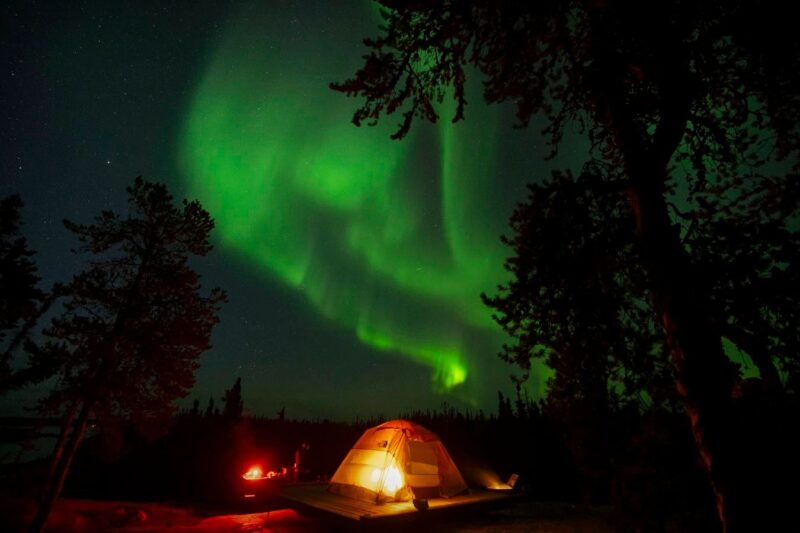The northern lights, also known as the aurora borealis, are seen in the night sky near Yellowknife in Canada’s Northwest Territories, early Wednesday, Aug. 20, 2025. (AP Photo/Mark Schiefelbein)
Copyright 2025 The Associated Press. All rights reserved.
The Northern Lights may be visible on camera — and possibly to the naked eye — across 12 northern U.S. states and Canada as soon as it gets dark on Monday, Oct. 27, according to a forecast from the National Oceanic and Atmospheric Administration’s Space Weather Prediction Center (SWPC). The forecast includes a minor geomagnetic storm that could see displays of aurora.
The culprit is a coronal hole on the sun, which creates streams of high speed solar wind that NOAA forecasters believe it will trigger a G1-rated geomagnetic storm — and auroras in northern U.S. states, Canada and northern Europe.
Solar activity is currently close to a 23-year high due to 2024’s solar maximum, the most active phase of the sun’s 11-year cycle. It’s expected to mean the Northern Lights will be frequently observable from northern U.S. states through 2026.
Northern Lights Forecast: What To Expect
A coronal mass ejection — a cloud of super-charged particles that leaves the sun and takes a few days to reach Earth —is expected to hit Earth’s magnetic field on Monday, Oct. 27.
“Active levels are likely on 27 Oct due to the anticipated arrival of the CME that left the Sun on 23 Oct. G1 (Minor) conditions, with a chance for G2 (Moderate), are likely on 28 Oct due to the anticipated onset of influence from a positive polarity coronal hole,” states NOAA.
According to Spaceweather.com, it’s a “low confidence forecast because of busy and confusing CME activity on Oct. 23rd, when this minor CME left the sun.”
NOAA’s aurora viewline map for Monday, Oct. 27, 2025.
NOAA
Northern Lights Forecast: Where And When
NOAA’s latest aurora viewlines indicate that aurora displays are a possibility in northern U.S. states and Canada, with 12 U.S. states having a chance after dark on Monday, Oct. 27.
U.S. states that may see aurora include Alaska and (northerly parts of) Washington, Idaho, Montana, Wyoming, North Dakota, South Dakota, Minnesota, Wisconsin, Michigan, New York and Maine.
Dark northern skies away from urban light pollution are likely to offer the best views.
Northern Lights: Avoiding Light Pollution
Urban glow is the aurora’s worst enemy. To escape it, drive 30–60 minutes from city centers or use light-pollution maps to locate darker skies. Even a modest reduction in brightness can reveal auroral structure invisible under urban haze. A handy way to locate a dark place is the Dark Sky Place Finder and a light pollution map.
Shield stray car lights and avoid using bright flashlights once you arrive. Red headlamps preserve night vision and courtesy to others. Dark-sky parks and lakeshores north of cities often make excellent viewing spots. The rule is simple: the darker the northern sky, the more vibrant the display — even during moderate geomagnetic storms.
The coronal hole on the sun as seen by NASA’s Solar Dynamic Observatory on Sunday, October 26, 2025.
NASA SDO
Northern Lights Forecast: How To Photograph Aurora
A mirrorless or DSLR camera is ideal (ISO 1600, 2-10 seconds, f2.8), though newer smartphones are increasingly capable of stunning results. If your smartphone has a Night Mode or Pro Mode, you can capture a beautiful aurora photo with these steps:
- Use your main lens, not the ultra-wide, for sharper results.
- Stabilize the camera using a tripod or rest it on a firm surface such as a car roof, wall, or post.
- Shoot in RAW format if available, as it allows easier post-editing.
- Expect long exposures between five and ten seconds. Even faint glows that look grayish to the eye often appear vividly green, purple or red in photos.
Northern Lights Forecast: Latest Updates And Auroral Substorms
All forecasts for the aurora must be treated with caution. To check visibility in real time, use NOAA’s 30-minute aurora forecast, or download apps such as Aurora Now, My Aurora Forecast or Glendale Aurora for up-to-the-minute alerts and live solar wind data.
Aurora-chasers frequently use the Kp index to predict the intensity of a geomagnetic storm, but for aurora displays, the interplanetary magnetic field’s Bz component is more important (you’ll find it in some of the above apps and on SpaceWeatherLive.com).
Bz determines how easily solar energy enters Earth’s magnetosphere. When Bz points north, Earth’s field resists it; when Bz swings south, the two fields connect, allowing plasma to stream in. A sustained southward Bz of −5 nT or stronger usually signals an imminent display of aurora.
Wishing you clear skies and wide eyes.









